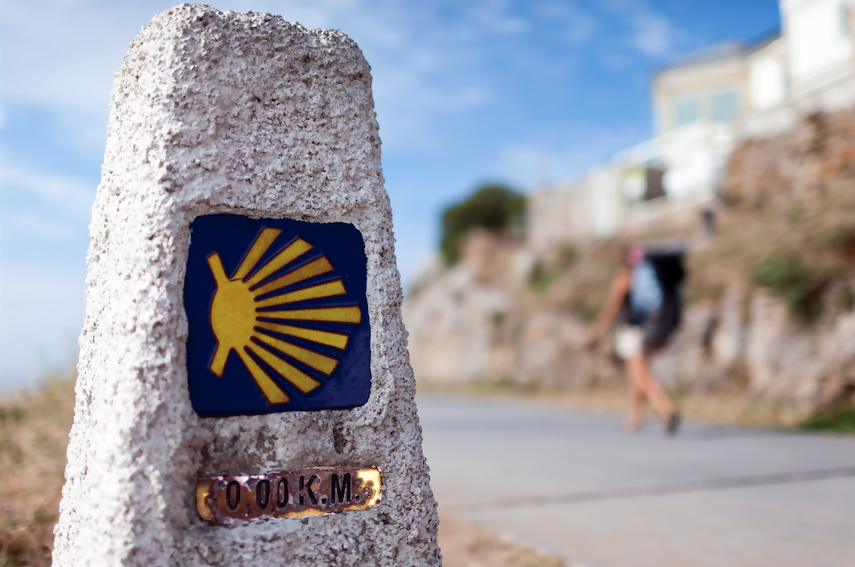It's been a physical test of spirituality since the Middle Ages. And more recently, Christian pilgrims have been joined by active travel enthusiasts on the Camino de Santiago, a 500-mile (800 km) route across northern Spain to the Cathedral of Santiago de Compostela in Galicia.
Whether you're making a modern-day pilgrimage for your own spiritual growth, interested in retracing the most renowned historic pilgrimage trail in Europe, or just hiking or cycling this famous trail, here's what you need to know about Spain's Camino de Santiago.
The Way of St. James
'Santiago' derives from the Latin for Saint James. Legend says that one of Jesus' 12 apostles, James, left Jerusalem to preach in Spain. After some time, he felt called to return to Jerusalem, where he was martyred. Hundreds of years after his death in the Holy Land, his remains were transported on an epic journey to a shrine in his honor in northern Spain.
By the 9th century, those traditions had become the basis for the most famous pilgrimage site and route in the Christian world, following the 'Way of St. James' to pray at his shrine, where the Santiago de Compostela Cathedral was built. Saint James also became the patron saint of Spain.
Over the centuries, a number of rallying points and routes for pilgrims were established from over Europe, converging from all directions on the Cathedral.
Today, over two-thirds of people take the 'French Route' that crosses from France into Spain through the Pyrenees mountains. Many modern-day travelers trail rally in the Spanish city of Pamplona (of bull run fame) before setting off on the trek west.
Centuries-Old Traditions
Early pilgrims took months or even years to reach their destination. The scallop shell became the symbol of the pilgrimage. They are plentiful on the beaches of Galicia, and originally may have been practical for scooping shared food and water, as well as a souvenir of the life-changing journey. Pilgrims still wear a shell to show they are on the Camino de Santiago pilgrimage.
In a natural gesture of relief and thanks, pilgrims (many collapsing) laid their hands on the pillar just inside the doorway of the cathedral on arrival, and most modern pilgrims follow suit. Over the centuries, the clutch of countless grateful hands has worn away at the stone.
Many pilgrims in early times arrived ill and sometimes penniless, with their money stolen or spent along the way. They stayed at and were cared for along the way in pilgrimage hostels, mostly run by monks or nuns.
Hostels for those with a 'credencial' or 'pilgrim's passport' remain and some have even become famous hotels that cater for free to a limited number of pilgrims.
Most pilgrims then and now buy and carry the credencial, which gives you access to these accommodations along the way. It also becomes a record of your journey. You get an official St. James stamp in each town you eat, or hostel you stay at along the way, and provides proof to the Pilgrim's Office once you reach Santiago that you have completed the official route and qualify for a 'compostela' – a certificate of completion.
A Pilgrim's Mass is held in the Cathedral of Santiago de Compostela twice daily, and pilgrims who received their compostela the day before have their countries and where they started their journeys announced during Mass. On Fridays, the world's largest incense burner is swung dramatically around the cathedral in a symbolic cleansing.
The Pilgrimage Today
So many pilgrims were walking across Spain to the shrine, it was imagined the dust from the non-stop pilgrim traffic rose all the way to the heavens, and the Spanish phrase for the Milky Way became El Camino de Santiago! But as religious devotion dropped, so did the number of pilgrims.
By the 1980's, only a few hundred people a year traveled the Way of St. James. Then, in 1987, it was declared the first European Cultural Route and a UNESCO World Heritage Site. Modern pilgrims and secular active travelers re-discovered the appeal of the historic route.
These days, 300,000 or more people make the trip every year on foot, by bicycle or horseback, and in escorted tours by vehicle that stop at highlights along the way. Scallop shell markers, including brass shells inlaid in cobblestone paths, or stylized sideways shells, often gold on a blue background on signposts or buildings still mark the way through towns and countryside.
The trip on foot from the Spanish border nowadays takes about a month.
Not everyone who walks on the Camino receives a compostela, but you can still earn one without a month-long commitment. To qualify, you must make the pilgrimage for religious or spiritual reasons, even if they are your own spirituality and inner quest, do the last 100 km (approx 60 miles) on foot or horseback, or the last 200 km (approx 120 miles) by bicycle, AND you still need to collect a certain number of stamps in your credencial which you present at the Pilgrim's Office in Santiago de Compostela.
Whenever St. James' Day, July 25th, falls on a Sunday, the cathedral declares a Holy, or Jubilee Year with special commemorations and a spike in pilgrimages. 2021 and 2027 are this decade's Jubilee Years.
The traditions, history and commitment to achieve this physical feat are transformative for both the faithful and the non-religious who successfully complete the Way of St. James in Spain.
Start your Trip!
Copyright BestTrip.TV/Influence Entertainment Group Inc or Rights Holder. All rights reserved. You are welcome to share this material from this page, but it may not be published, broadcast, rewritten or redistributed.







